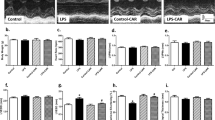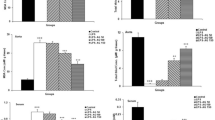Abstract
Betulinic acid (BA), a pentacyclic triterpenoid, has been reported to inhibit cardiovascular dysfunction under sepsis-induced oxidative stress. Nuclear factor erythroid-2 related factor-2 (Nrf2) is regarded as a key transcription factor regulating expression of endogenous antioxidative genes. To explore the preventive effects of BA against vascular hyporeactivity and the related antioxidative mechanism in sepsis, contraction and relaxation in aortas isolated from lipopolysaccharide (LPS)-challenged rats were performed. Male Sprague–Dawley rats were pretreated with brusatol (Bru, 0.4 mg/kg/2 days, i.p.), an inhibitor of Nrf2, and BA (10, 25, 50 mg/kg/day, i.g.) for 3 days and injected with LPS (10 mg/kg, i.p.) at the 4th day. Rats were anesthetized and killed by cervical dislocation after they were treated with LPS for 4 h. Thoracic aortas were immediately dissected out to determine contraction and relaxation using the organ bath system. Pro-inflammatory factors interleukin-1β (IL-1β) and tumor necrosis factor-α (TNF-α) and oxidative stress were measured in aortic tissues and plasma. mRNA expression of Nrf2-regulated antioxidative enzymes, including superoxide dismutase (SOD), glutathione peroxidase (GPx), and heme oxygenase-1 (HO-1), in rat aortas was determined. Increases of IL-1β, TNF-α, nitric oxide, and malondialdehyde and the decrease of glutathione induced by LPS were significantly attenuated by pretreatment with different doses of BA in plasma and aortas (p < 0.05 versus LPS), all of which were blocked by Bru (p < 0.01). Inhibition of phenylephrine (PE)- and KCl-induced contractions and acetylcholine (ACh)-induced vasodilatation in aortas from LPS-challenged rats was dose-dependently reduced by BA (p < 0.05; percentage improvements by BA in PE-induced contraction were 55.38%, 96.41%, and 104.33%; those in KCl-induced contraction were 15.11%, 23.96%, and 22.96%; and those in ACh-induced vasodilatation were 16.08%, 42.99%, and 47.97%), all of which were reversed by Bru (p < 0.01). Improvements of SOD, GPx, and HO-1 mRNA expression conferred by BA in LPS-challenged rat aortas were inhibited by Bru (p < 0.01; 145.45% versus 17.42%, 160.69% versus 22.76%, and 166.88% versus 23.57%). These findings suggest that BA attenuates impairments of aortic contraction and relaxation in LPS-challenged rats by activating Nrf2-regulated antioxidative pathways.







Similar content being viewed by others
References
Abdel-Salam OM, Abdel-Rahman RF, Sleem AA, Farrag AR (2012) Modulation of lipopolysaccharide-induced oxidative stress by capsaicin. Inflammopharmacology 20:207–217. https://doi.org/10.1007/s10787-011-0101-9
Adeleke GE, Adaramoye OA (2017) Betulinic acid protects against N-nitrosodimethylamine-induced redox imbalance in testes of rats. Redox Rep 22:556–562. https://doi.org/10.1080/13510002.2017.1322750
Annane D, Bellissant E, Cavaillon JM (2005) Septic shock. Lancet 365:63–78. https://doi.org/10.1016/s0140-6736(04)17667-8
Araujo JA, Zhang M, Yin F (2012) Heme oxygenase-1, oxidation, inflammation, and atherosclerosis. Front Pharmacol 3:119. https://doi.org/10.3389/fphar.2012.00119
Bhavsar TM, Cantor JO, Patel SN, Lau-Cam CA (2009) Attenuating effect of taurine on lipopolysaccharide-induced acute lung injury in hamsters. Pharmacol Res 60:418–428. https://doi.org/10.1016/j.phrs.2009.05.006
Chen Y, Luan L, Wang C et al (2019) Dexmedetomidine protects against lipopolysaccharide-induced early acute kidney injury by inhibiting the iNOS/NO signaling pathway in rats. Nitric Oxide 85:1–9. https://doi.org/10.1016/j.niox.2019.01.009
Costa JF, Barbosa-Filho JM, Maia GL et al (2014) Potent anti-inflammatory activity of betulinic acid treatment in a model of lethal endotoxemia. Int Immunopharmacol 23:469–474. https://doi.org/10.1016/j.intimp.2014.09.021
Cruzat VF, Bittencourt A, Scomazzon SP, Leite JS, de Bittencourt PI Jr, Tirapegui J (2014) Oral free and dipeptide forms of glutamine supplementation attenuate oxidative stress and inflammation induced by endotoxemia. Nutrition 30:602–611. https://doi.org/10.1016/j.nut.2013.10.019
Cuzzocrea S, Mazzon E, Di Paola R et al (2006) A role for nitric oxide-mediated peroxynitrite formation in a model of endotoxin-induced shock. J Pharmacol Exp Ther 319:73–81. https://doi.org/10.1124/jpet.106.108100
De Backer D, Orbegozo Cortes D, Donadello K, Vincent JL (2014) Pathophysiology of microcirculatory dysfunction and the pathogenesis of septic shock. Virulence 5:73–79. https://doi.org/10.4161/viru.26482
Durante W (2010) Targeting heme oxygenase-1 in vascular disease. Curr Drug Targets 11:1504–1516
El-Awady MS, Nader MA, Sharawy MH (2017) The inhibition of inducible nitric oxide synthase and oxidative stress by agmatine attenuates vascular dysfunction in rat acute endotoxemic model. Environ Toxicol Pharmacol 55:74–80. https://doi.org/10.1016/j.etap.2017.08.009
Fu JY, Qian LB, Zhu LG et al (2011) Betulinic acid ameliorates endothelium-dependent relaxation in l-NAME-induced hypertensive rats by reducing oxidative stress. Eur J Pharm Sci 44:385–391. https://doi.org/10.1016/j.ejps.2011.08.025
Galley HF (2011) Oxidative stress and mitochondrial dysfunction in sepsis. Br J Anaesth 107:57–64. https://doi.org/10.1093/bja/aer093
Gao F, Li JM, Xi C et al (2019) Magnesium lithospermate B protects the endothelium from inflammation-induced dysfunction through activation of Nrf2 pathway. Acta Pharmacol Sin. https://doi.org/10.1038/s41401-018-0189-1
Godugu C, Patel AR, Doddapaneni R, Somagoni J, Singh M (2014) Approaches to improve the oral bioavailability and effects of novel anticancer drugs berberine and betulinic acid. PLoS One 9:e89919. https://doi.org/10.1371/journal.pone.0089919
Han X, Yao W, Liu Z et al (2016) Lipoxin A4 preconditioning attenuates intestinal ischemia reperfusion injury through Keap1/Nrf2 athway in a lipoxin A4 receptor independent manner. Oxid Med Cell Longev 2016:9303606. https://doi.org/10.1155/2016/9303606
Jaiswal AK (2004) Nrf2 signaling in coordinated activation of antioxidant gene expression. Free Radic Biol Med 36:1199–1207. https://doi.org/10.1016/j.freeradbiomed.2004.02.074
Khodir AE, Ghoneim HA, Rahim MA, Suddek GM (2016) Montelukast attenuates lipopolysaccharide-induced cardiac injury in rats. Hum Exp Toxicol 35:388–397. https://doi.org/10.1177/0960327115591372
Kim KS, Lee DS, Kim DC et al (2016) Anti-inflammatory effects and mechanisms of action of coussaric and betulinic acids isolated from Diospyros kaki in lipopolysaccharide-stimulated RAW 264.7 macrophages. Molecules 21:E1206. https://doi.org/10.3390/molecules21091206
Kowalczyk A, Jelen A, Zebrowska M, Balcerczak E, Goraca A (2016) BQ123 stimulates skeletal muscle antioxidant defense via Nrf2 activation in LPS-treated rats. Oxid Med Cell Longev 2016:2356853. https://doi.org/10.1155/2016/2356853
Kukongviriyapan U, Sompamit K, Pannangpetch P, Kukongviriyapan V, Donpunha W (2012) Preventive and therapeutic effects of quercetin on lipopolysaccharide-induced oxidative stress and vascular dysfunction in mice. Can J Physiol Pharmacol 90:1345–1353. https://doi.org/10.1139/y2012-101
Landry DW, Oliver JA (2001) The pathogenesis of vasodilatory shock. N Engl J Med 345:588–595. https://doi.org/10.1056/NEJMra002709
Li YY, Cheung BM, Wong LY, Hwang IS, Kumana CR, Tang F (2005) Adrenomedullin gene expression and levels in the cardiovascular system after treatment with lipopolysaccharide. Neuropeptides 39:73–80. https://doi.org/10.1016/j.npep.2004.11.002
Lingaraju MC, Pathak NN, Begum J et al (2015a) Betulinic acid negates oxidative lung injury in surgical sepsis model. J Surg Res 193:856–867. https://doi.org/10.1016/j.jss.2014.09.008
Lingaraju MC, Pathak NN, Begum J et al (2015b) Betulinic acid attenuates renal oxidative stress and inflammation in experimental model of murine polymicrobial sepsis. Eur J Pharm Sci 70:12–21. https://doi.org/10.1016/j.ejps.2015.01.001
Luo JF, Shen XY, Lio CK et al (2018) Activation of Nrf2/HO-1 pathway by nardochinoid C inhibits inflammation and oxidative stress in lipopolysaccharide-stimulated macrophages. Front Pharmacol 9:911. https://doi.org/10.3389/fphar.2018.00911
Magesh S, Chen Y, Hu L (2012) Small molecule modulators of Keap1–Nrf2–ARE pathway as potential preventive and therapeutic agents. Med Res Rev 32:687–726. https://doi.org/10.1002/med.21257
Maiorino M, Thomas JP, Girotti AW, Ursini F (1991) Reactivity of phospholipid hydroperoxide glutathione peroxidase with membrane and lipoprotein lipid hydroperoxides. Free Radic Res Commun 12–13(Pt 1):131–135
McCreath G, Scullion MM, Lowes DA, Webster NR, Galley HF (2016) Pharmacological activation of endogenous protective pathways against oxidative stress under conditions of sepsis. Br J Anaesth 116:131–139. https://doi.org/10.1093/bja/aev400
Nader MA, Baraka HN (2012) Effect of betulinic acid on neutrophil recruitment and inflammatory mediator expression in lipopolysaccharide-induced lung inflammation in rats. Eur J Pharm Sci 46:106–113. https://doi.org/10.1016/j.ejps.2012.02.015
Ozer EK, Goktas MT, Toker A, Bariskaner H, Ugurluoglu C, Iskit AB (2017) Effects of carvacrol on survival, mesenteric blood flow, aortic function and multiple organ injury in a murine model of polymicrobial sepsis. Inflammation 40:1654–1663. https://doi.org/10.1007/s10753-017-0605-6
Qian LB, Wang HP, Chen Y et al (2010) Luteolin reduces high glucose-mediated impairment of endothelium-dependent relaxation in rat aorta by reducing oxidative stress. Pharmacol Res 61:281–287. https://doi.org/10.1016/j.phrs.2009.10.004
Ramachandran G (2014) Gram-positive and gram-negative bacterial toxins in sepsis: a brief review. Virulence 5:213–218. https://doi.org/10.4161/viru.27024
Remick DG (2007) Pathophysiology of sepsis. Am J Pathol 170:1435–1444. https://doi.org/10.2353/ajpath.2007.060872
Rokhade AP, Agnihotri SA, Patil SA, Mallikarjuna NN, Kulkarni PV, Aminabhavi TM (2006) Semi-interpenetrating polymer network microspheres of gelatin and sodium carboxymethyl cellulose for controlled release of ketorolac tromethamine. Carbohydr Polym 65:243–252. https://doi.org/10.1016/j.carbpol.2006.01.013
Saia RS, Bertozi G, Mestriner FL, Antunes-Rodrigues J, Queiroz Cunha F, Carnio EC (2013) Cardiovascular and inflammatory response to cholecystokinin during endotoxemic shock. Shock 39:104–113. https://doi.org/10.1097/SHK.0b013e3182793e2e
Saito T, Yamamoto Y, Feng GG, Kazaoka Y, Fujiwara Y, Kinoshita H (2017) Lidocaine prevents oxidative stress-induced endothelial dysfunction of the systemic artery in rats with intermittent periodontal inflammation. Anesth Analg 124:2054–2062. https://doi.org/10.1213/ane.0000000000002102
Sennoun N, Meziani F, Dessebe O et al (2009) Activated protein C improves lipopolysaccharide-induced cardiovascular dysfunction by decreasing tissular inflammation and oxidative stress. Crit Care Med 37:246–255. https://doi.org/10.1097/CCM.0b013e318192fe4f
Sutariya B, Taneja N, Saraf M (2017) Betulinic acid, isolated from the leaves of Syzygium cumini (L.) skeels, ameliorates the proteinuria in experimental membranous nephropathy through regulating Nrf2/NF-kappaB pathways. Chem Biol Interact 274:124–137. https://doi.org/10.1016/j.cbi.2017.07.011
Szabo C, Mitchell JA, Thiemermann C, Vane JR (1993) Nitric oxide-mediated hyporeactivity to noradrenaline precedes the induction of nitric oxide synthase in endotoxin shock. Br J Pharmacol 108:786–792
Viji V, Helen A, Luxmi VR (2011) Betulinic acid inhibits endotoxin-stimulated phosphorylation cascade and pro-inflammatory prostaglandin E(2) production in human peripheral blood mononuclear cells. Br J Pharmacol 162:1291–1303. https://doi.org/10.1111/j.1476-5381.2010.01112.x
Wang H, Khor TO, Saw CL et al (2010) Role of Nrf2 in suppressing LPS-induced inflammation in mouse peritoneal macrophages by polyunsaturated fatty acids docosahexaenoic acid and eicosapentaenoic acid. Mol Pharm 7:2185–2193. https://doi.org/10.1021/mp100199m
Wang S, Yang Z, Xiong F et al (2016) Betulinic acid ameliorates experimental diabetic-induced renal inflammation and fibrosis via inhibiting the activation of NF-kappaB signaling pathway. Mol Cell Endocrinol 434:135–143. https://doi.org/10.1016/j.mce.2016.06.019
Wu CC, Chiao CW, Hsiao G, Chen A, Yen MH (2001) Melatonin prevents endotoxin-induced circulatory failure in rats. J Pineal Res 30:147–156
Xie R, Zhang H, Wang XZ et al (2017) The protective effect of betulinic acid (BA) diabetic nephropathy on streptozotocin (STZ)-induced diabetic rats. Food Funct 8:299–306. https://doi.org/10.1039/c6fo01601d
Xu Z, Tong Q, Zhang Z et al (2017) Inhibition of HDAC3 prevents diabetic cardiomyopathy in OVE26 mice via epigenetic regulation of DUSP5-ERK1/2 pathway. Clin Sci (Lond) 131:1841–1857. https://doi.org/10.1042/cs20170064
Yang JT, Wang J, Zhou XR et al (2018) Luteolin alleviates cardiac ischemia/reperfusion injury in the hypercholesterolemic rat via activating Akt/Nrf2 signaling. Naunyn Schmiedebergs Arch Pharmacol 391:719–728. https://doi.org/10.1007/s00210-018-1496-2
Zakkar M, Van der Heiden K, le Luong A et al (2009) Activation of Nrf2 in endothelial cells protects arteries from exhibiting a proinflammatory state. Arterioscler Thromb Vasc Biol 29:1851–1857. https://doi.org/10.1161/atvbaha.109.193375
Zhou XR, Bai YY, Zhou HY, Yan D, Li WX, Qian LB (2018) Betulinic acid reduces the impairment of aortic contraction induced by lipopolysaccharide via reducing oxidative stress. Chin J Biochem Mol Biol 34:455–460. https://doi.org/10.13865/j.cnki.cjbmb.2018.04.14
Acknowledgements
This work was supported by National Natural Science Foundation of China (81772035), Xinmiao Talents Program of Zhejiang Province (2018R427001), Natural Science Program of Hangzhou Medical College (2016XZA04), and the Program of Cultivating Zhejiang Provincial High-level Personnel in Health (Excellent Medical Younger in 2018).
Author information
Authors and Affiliations
Corresponding authors
Ethics declarations
Conflict of interest
C. Xiao, the first corresponding author, L.-B. Qian, the second corresponding author, and all other authors declare that there are no conflicts of interest.
Additional information
Publisher's Note
Springer Nature remains neutral with regard to jurisdictional claims in published maps and institutional affiliations.
Rights and permissions
About this article
Cite this article
Bai, YY., Yan, D., Zhou, HY. et al. Betulinic acid attenuates lipopolysaccharide-induced vascular hyporeactivity in the rat aorta by modulating Nrf2 antioxidative function. Inflammopharmacol 28, 165–174 (2020). https://doi.org/10.1007/s10787-019-00622-4
Received:
Accepted:
Published:
Issue Date:
DOI: https://doi.org/10.1007/s10787-019-00622-4




